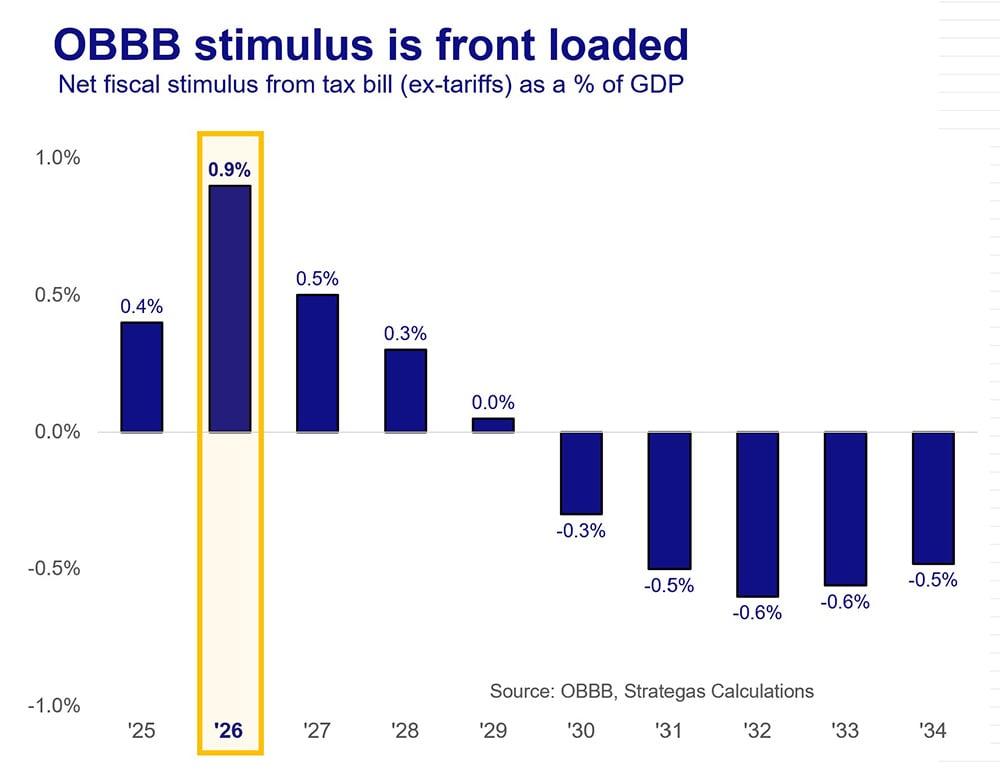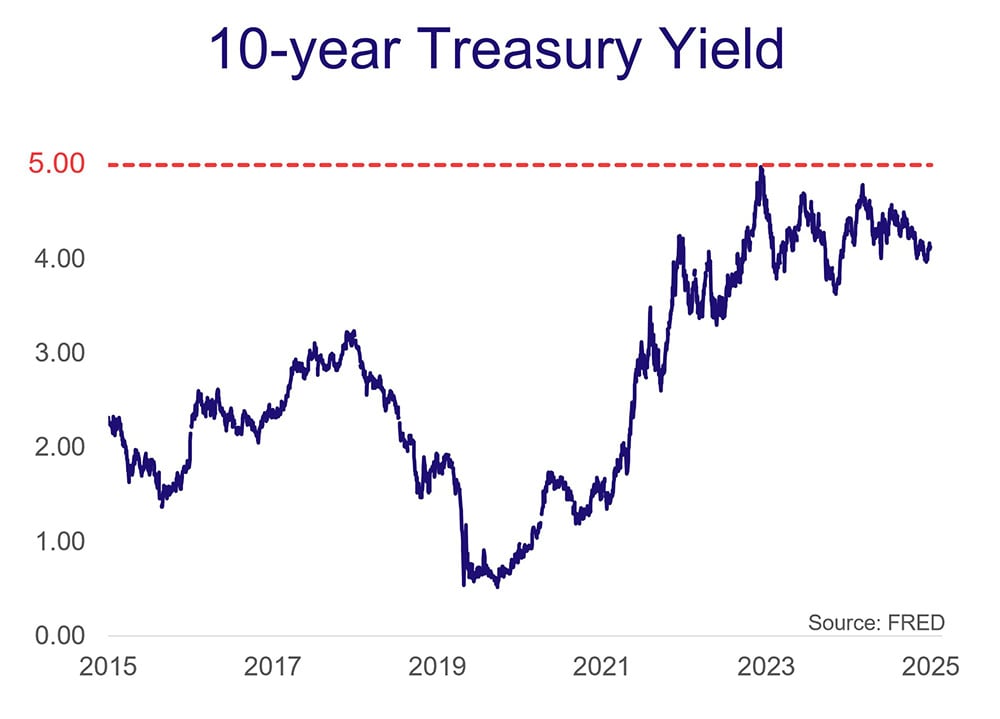Key Takeaways from Strategas Research Areas
At Strategas, we look at the markets and the economy from several angles. Periodically, we gather our research areas into one note that serves as a snapshot of where we are today and an outlook for the months ahead.
November 18, 2025
Investment Strategy
Jason Trennert, Chairman, Chief Investment Strategist
- Current concerns about 2025 capex and hiring stem from trade policy uncertainty and the gap between the July passage of the One Big Beautiful Bill and next year when the bill’s stimulus will largely come into effect. These concerns (plus the government shutdown) have likely created an economic “soft patch” in 4Q25. Economic risks should moderate in 2026 as OBBB incentives for capital and consumer spending take hold. While we anticipate choppier market action in the wake of a Q4 soft patch, easier monetary policy and fiscal stimulus will likely keep us out of recession territory.
- The rally will likely continue unless the 10-year Treasury yield breaches 4.5% (a level at which the market has struggled).
- The market is expensive by several metrics, but we think strong corporate profits have digested these elevated multiples. For Q3, S&P 500 earnings per share were up 13.5% year over year with revenue at a robust +8% y/y. Historically, the economy tends not to get in too much trouble when earnings growth is roughly twice the rate of GDP.
- Consensus estimates for 2026 revenue and profit growth moved higher (to +6% and +14% y/y) from an already healthy outlook. We see positive follow-through from corporate activity next year, albeit at slightly lower levels; we are estimating S&P 500 operating EPS between $285 and $290 (+9% y/y) next year vs. the consensus estimate of $305 (+14% y/y).
- We continue to focus on five major themes: 1) Cash flow aristocrats, 2) Artificial intelligence, 3) Industrial power generation, 4) Deglobalization, and 5) a 2026 consumption wave from OBBB stimulus, the World Cup, and America250.
Washington Policy
Dan Clifton, Head of Policy Research
- Shock & awe fiscal and monetary stimulus in place for 2026 sets up a cushion if the economy unexpectedly slows from here. Next year will feature nearly $300 billion of tax cuts for consumers and businesses at a time when the Fed is expected to cut rates and ease monetary policy. This one-two policy punch will mitigate the negative impact of tariffs, but with a gap before relief arrives in early 2026. A majority of Federal Reserve members worry about inflation when employment is slowing due to tariffs, and a delayed end of quantitative tightening is disrupting overnight lending markets. We believe the U.S. economy will be able to walk this tightrope and U.S. growth should accelerate in 2026.
- How, not if, on tariffs. Even if the Supreme Court rules that President Trump cannot use the International Emergency Economic Powers Act to impose tariffs, he has a plan to reimpose the tariffs. First, Trump will likely impose Section 122 tariffs of up to 15% on countries for balance of payment issues for 150 days. While the Section 122 tariffs are in effect, Section 301 investigations into unfair trade practices will allow the president to reimpose tariffs under a more legally sound authority. A year from now, we expect the same level of tariffs as today. If the courts strike down the tariffs, a lengthy tariff refund process will likely be put into place to ensure integrity.

- Midterm election years are historically challenging for stocks. The average intra-year decline on the S&P 500 in a midterm election is 19% and nearly 700 basis points above the average in the other three years of the presidential cycle. As such, the equity market tends to be more defensive in a midterm election year with Healthcare and Consumer Staples the two top-performing sectors. The S&P 500 has not declined in the 12 months following a midterm election since 1942. We have found midterm election year selloffs to be buying opportunities in the past.
- Democratic sweep in the Nov. 4 elections could be a preview for midterms. November elections confirmed that Democratic voters are much more motivated to vote than Republicans, a trend that we saw in special elections all year. The U.S. has moved eight points to the Democrats since the 2024 election. If this trend continues, Democrats are likely to gain control of the House in the 2026 midterms.
Economics
Don Rissmiller, Chief Economist
- Growth. Timely U.S. data have already shown rolling weakness in housing and manufacturing. There is further downward pressure on activity in 2025 from the tariff shock and government shutdown in Q4. True, there is significant fiscal stimulus for consumers in the pipeline, but this is mainly a 2026 story. We are using a 35% chance of a U.S. recession, 50% soft landing, and 15% upside surprise in 2025. For 2026, our odds are a 20% chance recession, 60% soft landing/expansion, and 20% upside.
- Inflation. The 2022 wave of U.S. inflation now appears to be over (inflation expectations still look anchored). But history suggests that once inflation gets going, a second wave tends to build over the next several years (87% of the time, globally). We’re in the lull between waves thus far. Fortunately, supply chain problems related to tariff implementation have not been significant yet. Domestic rents also remain in a slowing trend.
- Policy. 2024 saw lower monetary policy rates, justified first by inflation coming down and reinforced by cracks in the employment situation. The Fed’s goal should be to get monetary policy back to a neutral setting, in our opinion. That requires several more rate cuts, but the FOMC does not appear to be in a rush in Q4. The lack of government data due to the shutdown may be causing some policymakers to move cautiously.

- Risks. The fiscal support that allowed prior growth have not been cost-free. The U.S. federal budget deficit remains large and while there’s no emergency, the deficit threatens to crowd out other economic activity (though this does not appear to be happening yet). Fixing this abruptly would risk an economic stop. Alternatively, inflation could return over time if inflation expectations become unanchored due to repeated shocks.
- Hope. Productivity (more output per hour) can conceptually help alleviate a second inflation wave. Too much money chasing too few goods can be stymied by producing more goods. While there is promise on this front from technological advances, we would like to see growth in profits of both the producers of new technology such as AI and the users of that technology at the same time.
Asset Allocation
Nicholas Bohnsack, President, Head of Portfolio Strategy
- Following elevated uncertainty in 2Q25 (after April’s tariff announcements), volatility settled in for 3Q25 and set about reclaiming lost ground. Subtle but clear shifts in sentiment followed in the post-Labor Day period as the market waited on the Fed and suspicions arose as to whether current levels of capex spending will persist long enough to substantiate the AI productivity promise and the lofty valuations of AI-related sectors.
- We remain less enthusiastic about putting new money to work in U.S. Large-Cap Growth, believing the incremental value is shifting away from the hyperscalers and toward the industrial power players in the U.S. Large and Mid-Cap Value segments. Over the long-term, Small Caps and Value stocks will have a difficult time outperforming until the Fed permits a real business cycle to take place. We favor Financials, Industrials, Utilities, and Consumer Discretionary among U.S. equity sectors.
- Treasury yields do not appear to be flashing a warning signal. Credit spreads are just off the tights, perhaps responding to softer Q4 economic conditions, but remaining well behaved. Adding to existing exposure, however, doesn’t seem appropriate. We recommend managing fixed income sector exposure vs. increased gross asset class exposure.
- We believe conditions warrant higher long-term allocation to Gold and other alternative assets. Over the longer term, we maintain Gold is likely to serve as a core allocation in this period of deglobalization and accelerated phase of de-dollarization, as well as a transition asset during heightened uncertainty and central bank balance sheet distortion.
Technical Strategy
Chris Verrone, Head of Macro And Technical Strategy
- The recent unwind in high beta stocks (i.e., higher growth/volatility) is rotational and more a reflection of crowded positioning and weak hands, rather than some ominous economic message. We of course hold this view (and all views) lightly, as we know the market can change its mind fast, but we don’t want to forget that the majority of global markets remain in uptrends, Bank stocks remain the leadership almost everywhere we look, and recent weakness has been more rotational than outright distributive—a positive sign in our book.
- After running hot for nearly 7 months, anything in the aforementioned “high beta” category has been hit over recent weeks…notably, the peak in the “beta” factor has rarely coincided with the peak in the market over the last 30+ years.
- 20-day lows are actually contracting for both Discretionary and Financials (neither sector getting worse the last two weeks), while new highs are expanding for both Healthcare and Energy, in step with the market’s rotational spirit. Among the more recent leadership stories, Healthcare is in the strongest technical position with internal trends continuing to improve and (like Energy) enjoying the advantage of a very low bar of expectations.
- Within Tech, we distinguish between overbought/extended stocks correcting (e.g., Semis) and multi-month or even multi-year top formations (e.g., legacy Software). The implications for each are different. We’d be more open to buying oversold conditions for the former as they develop over the coming weeks/months.
- Bitcoin and Private Capital stocks are two blemishes – the extent both rely on a narrative and a healthy liquidity backdrop to work, their prolonged absence from right side of the tape remains noted.
- Commodities are firming, with the Bloomberg Commodity Index breaking out this week to multi-year highs on the back of Base Metals and Natural Gas. Notably, we’ve observed a bounty of “real economy” breakouts to our east – Chinese Aluminum and Steel stocks are flying, the Aussie Materials sector has broken out (along with Aussie short rates), and even the European Basic Resources group has turned positive in our model.

Fixed Income
Tom Tzitzouris, Head of Fixed Income Research
- The path of rates and credit spreads over the next 3, 6, and 12 months will be largely determined by 1) how much economic damage has been done by the government shutdown, and 2) how quickly and thoroughly does 2026 stimulus begin to offset that weakness.
- Rates outlook. We expect the near-term effects of the shutdown will be such that the Fed will find little choice but to cut again in December. This should be accompanied by a modest migration lower in yields across most of the curve as 2025 comes to a close. But this bond rally should be short-lived as stimulus picks up by the middle of Q1 and gains steam. This should make the odds of a Q1 rate cut no better than 50-50, with diminishing odds of any additional cuts beyond Q1. At the same time, the stream of business and household stimulus, combined with World Cup and the 250th birthday of the U.S., should be enough to bring on the return of the bear market steepener by early Q2. We could eventually see 10-year yields make a credible move back toward 5.0% by the end of 2026.

- Credit spreads. Consistent with the stop-and-go economy over the next 12 months, we expect to see credit spreads wobble slightly higher between now and early 2026. Investment grade spreads should reach back up to and above 100 basis points (i.e., 1 percentage point), and largely hold there for most of 2026. In contrast to growth and rates, which should both continue to trend as 2026 progresses, investment grade spreads may not move materially below 100 bps in 2026 once they rise above that level. We attribute this slightly higher floor next year to two reasons; 1) the bear market curve steepener putting upward pressure on credit spreads even as growth remains strong, and 2) the unavoidable progression of the credit cycle, which is now 5 years in the making and looking long in the tooth.
Equity Derivatives
Brandon Kobelt, Head of Equity Derivatives Research
- Nervousness has returned in equities, with the VIX above 20 and the VXN above 25, as the S&P 500 and Nasdaq 100 show weakness led by selloffs in the Mag 7 and AI-related names.
- With renewed nerves, volatility skew has steepened versus the extreme flatness seen before earnings season, signaling that the prior call-chasing exuberance has faded.
- Although most of the earnings season has been solid, many stocks have seen difficult price action after delivering strong results. Of the six Mag 7 that have reported, all beat both revenue and earnings (except Tesla), but Amazon is the only name with notable upside since reporting Q3 earnings.
- The current backdrop features Tech/AI weakness and an increasingly hawkish Fed tone on the prospect of a December rate cut. Major events to watch into year-end include Nvidia’s earnings on November 19, the December 5 jobs report, and the FOMC rate decision on December 10.
- Despite the nervousness, we would keep in mind that since April 21, 2025, the S&P 500 has gained about +30% with a max drawdown of only −3% as of this writing.
Appendix – Important Disclosures
Past performance is not indicative of future results. This communication was prepared by Strategas Securities, LLC (“we” or “us”). Recipients of this communication may not distribute it to others without our express prior consent. This communication is provided for informational purposes only and is not an offer, recommendation or solicitation to buy or sell any security. Unless otherwise cited, market and economic statistics come from data providers Bloomberg and FactSet. This communication does not constitute, nor should it be regarded as, investment research or a research report or securities recommendation and it does not provide information reasonably sufficient upon which to base an investment decision. This is not a complete analysis of every material fact regarding any company, industry or security. Additional analysis would be required to make an investment decision. This communication is not based on the investment objectives, strategies, goals, financial circumstances, needs or risk tolerance of any particular client and is not presented as suitable to any other particular client. Investment involves risk. You should review the prospectus or other offering materials for an investment before you invest. You should also consult with your financial advisor to assist you with your analysis, risk evaluation, and decision-making regarding any investment.
Baird does not currently recommend the purchase of any cryptocurrencies, products that attempt to track cryptocurrencies, or cryptocurrency custodians. Baird does not custody Bitcoin or any other cryptocurrencies.
The performance and other information presented in this communication is not indicative of future results. The information in this communication has been obtained from sources we consider to be reliable, but we cannot guarantee its accuracy. The information is current only as of the date of this communication and we do not undertake to update or revise such information following such date. To the extent that any securities or their issuers are included in this communication, we do not undertake to provide any information about such securities or their issuers in the future. We do not follow, cover or provide any fundamental or technical analyses, investment ratings, price targets, financial models or other guidance on any particular securities or companies. Further, to the extent that any securities or their issuers are included in this communication, each person responsible for the content included in this communication certifies that any views expressed with respect to such securities or their issuers accurately reflect his or her personal views about the same and that no part of his or her compensation was, is, or will be directly or indirectly related to the specific recommendations or views contained in this communication. This communication is provided on a “where is, as is” basis, and we expressly disclaim any liability for any losses or other consequences of any person’s use of or reliance on the information contained in this communication.
Strategas Securities, LLC is affiliated with Robert W. Baird & Co. Incorporated (“Baird”), a broker-dealer and FINRA member firm, although the two firms conduct separate and distinct businesses. A complete listing of all applicable disclosures pertaining to Baird with respect to any individual companies mentioned in this communication can be accessed at https://www.rwbaird.com/research-coverage/. You can also call 1- 800-792-2473 or write: Baird PWM Research & Analytics, 777 East Wisconsin Avenue, Milwaukee, WI 53202.


